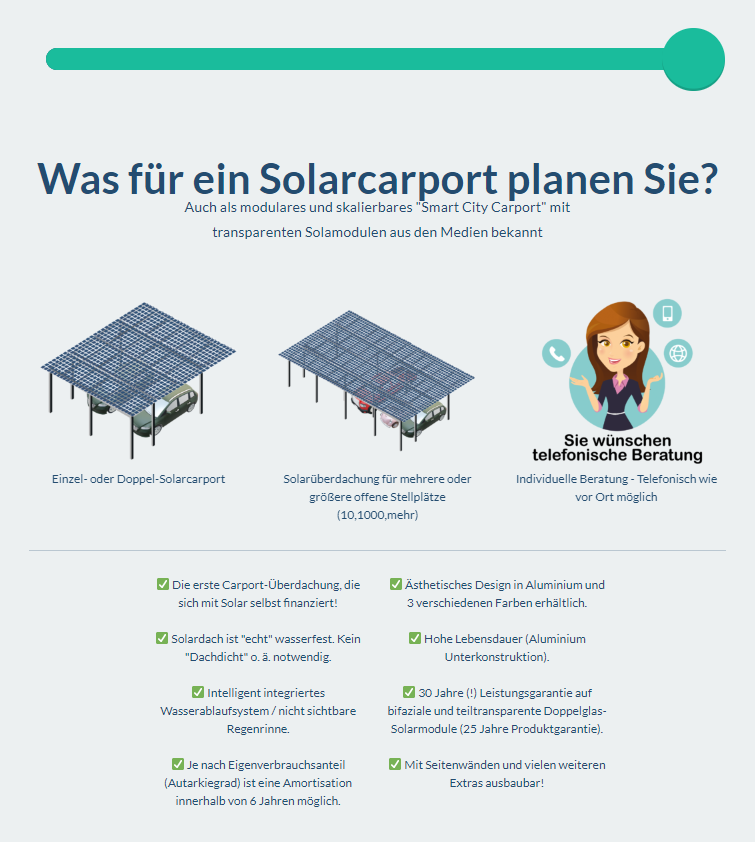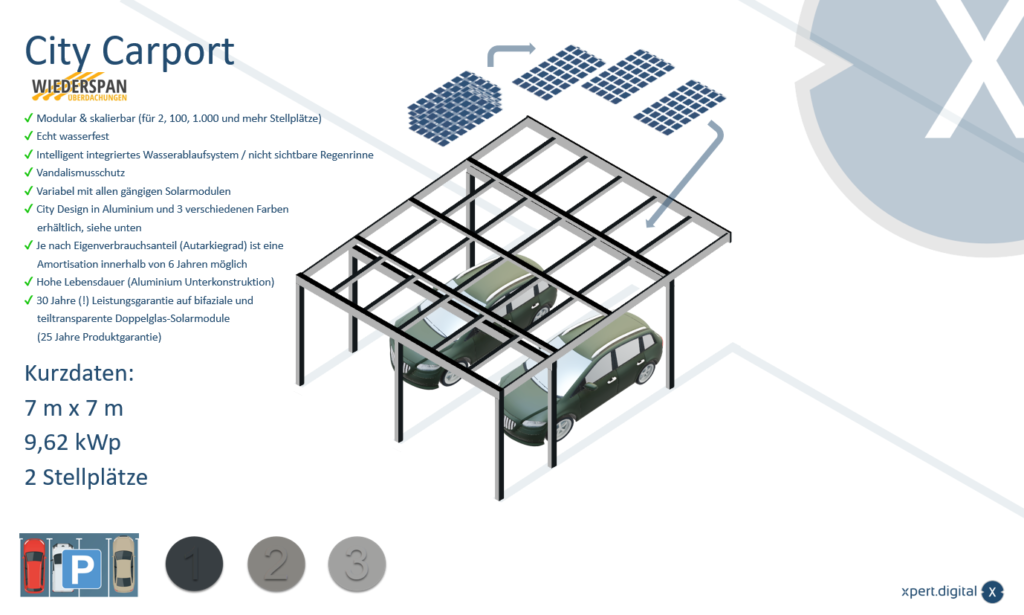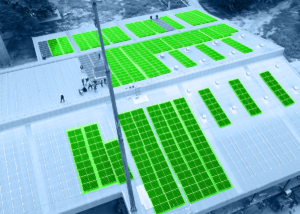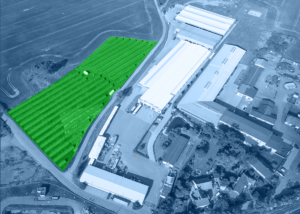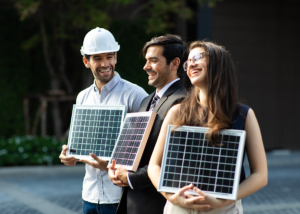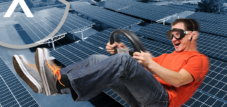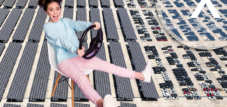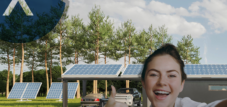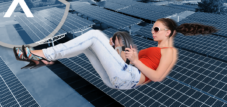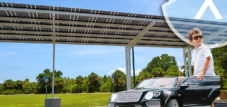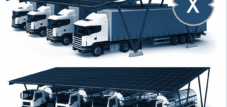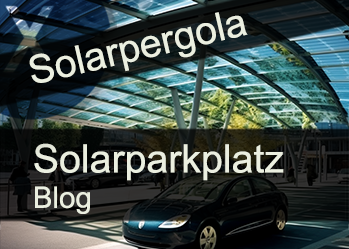Solar/photovoltaic parking lot: Special solar roofing systems for parking lot roofing and large-area carports
Language selection 📢
Published on: June 26, 2023 / update from: June 26, 2023 - Author: Konrad Wolfenstein
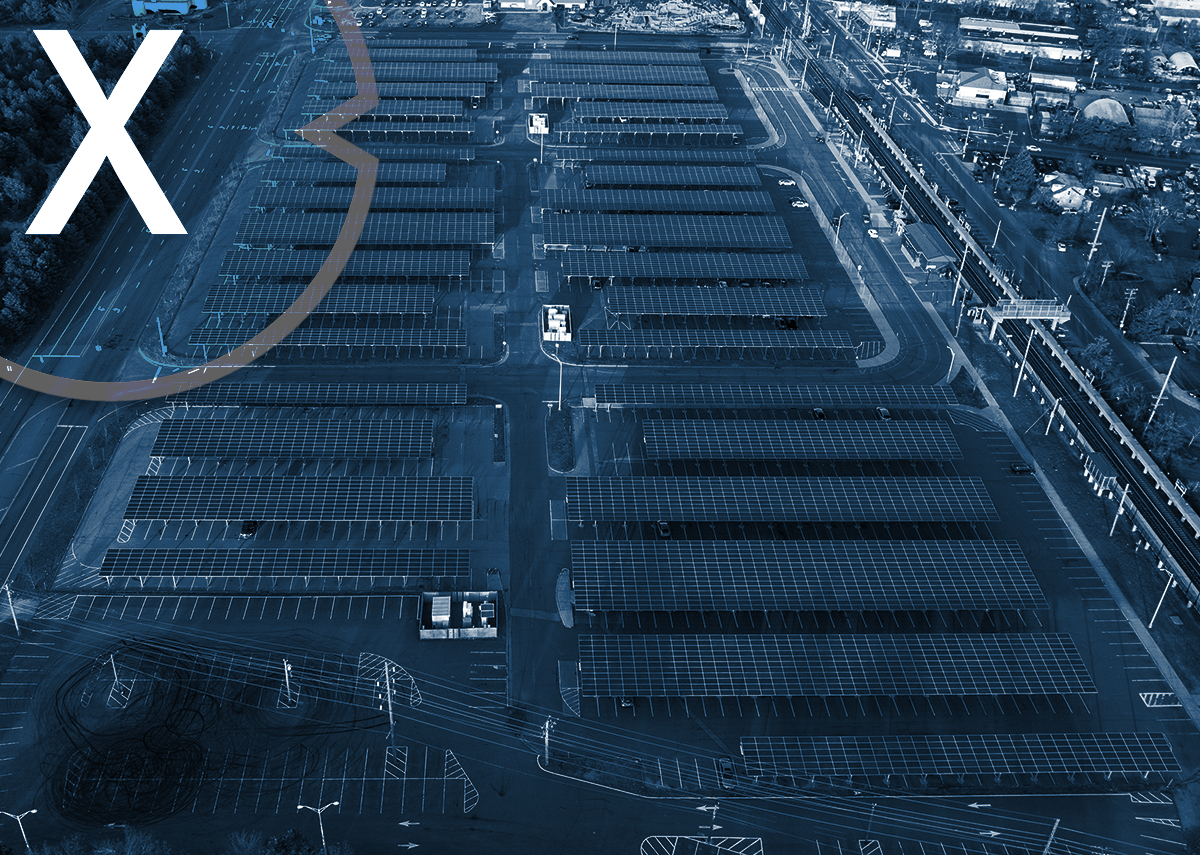
Special solar roofing systems for parking lot roofing, large area carports or parking lot roofing in general - Image: Audley C Bullock|Shutterstock.com
Efficient and sustainable: The future of parking lot roofing with special solar roofing systems
Special solar roofing systems, such as solar parking lot roofs or large carports, are playing an increasingly important role in the use of renewable energies and the promotion of sustainable energy solutions. These systems not only provide protection from the elements, but also harness the power of the sun to produce clean and renewable energy.
Solar parking lot roofing is an innovative way to make optimal use of unused space in parking lots. By installing solar panels on parking lot roofs, companies and organizations can both protect their vehicles and generate green energy. These canopies are typically designed to cover a large area while allowing for efficient energy production.
Another interesting solar roofing system is large-area carports. These are often used in commercial and industrial areas to cover large parking lots while generating renewable energy. Large area carports not only offer protection from the elements, but also enable companies to meet their energy needs by using solar energy. In addition, they can serve as charging stations for electric vehicles, helping to further promote sustainable mobility.
Solar parking lot enclosures are extremely versatile and can be adapted to different locations. They can be installed in residential areas, shopping malls, hospitals, universities and other public facilities. By installing solar panels on parking lot canopies, these locations can not only meet their energy needs, but also feed excess energy into the power grid.
An important advantage of such solar roofing systems is the reduction of CO2 emissions. By using renewable energy sources such as the sun, companies and organizations can reduce their environmental footprint and help combat climate change. In addition, they can benefit from government incentives and support programs that support the installation of solar energy systems.
There are also innovative technologies that can be integrated into solar roofing systems. For example, intelligent sensors and control systems can be used to optimize energy yield and monitor energy consumption. These systems can analyze sunlight output, track solar panels, and control energy flow to ensure maximum efficiency and performance.
Additionally, solar canopy systems can be combined with energy storage solutions to store the energy produced and use it when needed. This enables a continuous supply of energy even when the sun is not shining and helps stabilize the power grid.
➡️ Solar roofing systems such as solar parking lot roofs, large carports and parking lot roofs offer a sustainable and efficient way to generate renewable energy and make optimal use of unused areas. With their versatile application potential and ecological benefits, these systems help promote a clean energy future and show how the integration of renewable energies into everyday life is becoming increasingly important.
The Xpert.Solar solar carport planner
Solar parking spaces are a promising way to generate renewable energy while optimizing limited space requirements in cities and urban areas. However, there are actually some challenges that can complicate the introduction of such parking spaces.
One of the biggest hurdles is the high cost and planning effort associated with installing solar panels in parking lots. Not only must the cost of the solar panels themselves be taken into account, but also the cost of the infrastructure required to connect the panels to the grid. In addition, the space required for installing the solar modules must be precisely planned and coordinated to ensure effective use of the available space.
Another obstacle are bureaucratic hurdles and approval processes that can make it difficult to install solar panels in parking lots. Depending on the region or country, different rules and regulations may apply, which can complicate the approval and implementation process.
Despite these challenges, there is high demand for solar parking spaces as they represent an effective way to promote renewable energy while optimizing space requirements in urban areas. With careful planning and collaboration between the parties involved, the hurdles can be overcome to facilitate the introduction of such parking spaces.
➡️ We specialize in providing advisory and planning support for such solar carport projects and advancing their implementation.
➡️ With our solar carport planner we simplify the process.
➡️ We are there for you for the next steps and thus minimize costs and effort for you.
More about it here:
Our favorite city solar carport or solar carport module
The advantages at a glance
- Support & Made in Germany
- Modular & scalable (for 2, 100, 1,000 and more parking spaces)
- Really waterproof
- Integrated water drain / invisible rain gutter
- Vandalism protection, optionally with integrated impact protection
- Variable with all common solar modules
- City design available in aluminum and 3 different colors
- Depending on the amount of self-consumption (degree of self-sufficiency), amortization is possible within 6 years
- Long service life (aluminum substructure)
- 30-year (!) performance guarantee on bifacial and partially transparent double-glass solar modules (25-year product guarantee)
- Reducing urban heat islands
- Building-integrated photovoltaics
- Ideal for transparent and translucent double-glass solar modules with overhead mounting approval!
📣 Parking areas solar solutions for industry, retail and municipalities
Everything from a single source, specially designed for solar solutions for large parking areas. You refinance or counterfinance into the future with your own electricity generation.
🎯 For solar engineers, plumbers, electricians and roofers
Advice and planning including a non-binding cost estimate. We bring you together with strong photovoltaic partners.
👨🏻 👩🏻 👴🏻 👵🏻 For private households
We are positioned across regions in German-speaking countries. We have reliable partners who advise you and implement your wishes.
Is there a difference between covered large-area carports (also large-area parks) and parking lot roofs?
Yes, there is a difference between large covered parking areas and parking lot covers, although both concepts perform similar functions. Here are some key details that clarify the difference between the two:
Size and coverage
Covered large-area parking facilities are generally larger than conventional parking lot covers. They cover a larger area and can cover several rows of parking spaces. Parking lot canopies, on the other hand, are typically smaller and typically only cover one or two rows of parking spaces.
Design and structure
Large covered parking areas are specifically designed to provide shelter for a large number of vehicles. They often have a sturdy and stable structure to withstand the elements while providing enough space for many cars. Parking lot canopies can have different designs depending on location and purpose and may not be as extensive as large area carports.
Additional functions
Due to their size and structure, large-area parks can often fulfill a variety of functions. For example, they can be equipped with charging stations for electric vehicles to promote environmentally friendly mobility. They can also serve as additional storage space or as a shelter for bicycles. Parking lot enclosures are typically less complex and focus primarily on protecting vehicles.
Location and areas of application
Large-scale parking systems are often used in commercial and industrial areas to meet the energy needs of large companies while providing protected parking spaces for employees and customers. Parking lot covers are found in a wider range of locations including residential areas, shopping centers, hospitals, schools and other public facilities.
➡️ It is important to note that the terms “large area parking systems” and “parking space roofs” can sometimes be used synonymously, since there is no uniform definition and the terms can be interpreted differently depending on the context. Ultimately, the choice between a large area carport and a parking space covering depends on the specific requirements of the location and the goals of the operator.
Difference between parking spaces and parking facilities
There is a clear difference between parking spaces and parking facilities, with the focus being on the definition of parking facilities without reference to parking garages.
Parking spaces
Parking spaces are individual areas or areas that are specifically intended for parking vehicles. They can be present both outdoors and in covered areas and are often located in various locations such as roadsides, shopping centers, company premises or residential areas. Parking spaces are usually less structured and can be of different sizes. They are often arranged in rows or grid patterns, providing space for individual vehicles to park.
Parking facilities
Parking facilities, on the other hand, are more comprehensive and structured areas that consist of a larger number of parking spaces. These facilities can be located in a central location and are designed to accommodate a larger number of vehicles. They can include multiple rows of parking spaces and can be laid out in various configurations, such as a circular, square or rectangular arrangement. Parking facilities can also offer additional functions, such as traffic management systems, signage or markings, to make orientation easier for drivers.
Organization and administration
Parking lots are often independent of each other and may be operated by different owners or organizations. The responsibility for maintenance and management often lies with the owner of the property or the relevant authority. Parking facilities, on the other hand, are usually planned, managed and operated as an entire unit. This means that they have a unified structure and are organized by a single entity or company. The parking facilities can also offer special services such as parking monitoring, security or access controls.
Use and purpose
Parking lots are primarily used to provide temporary space for vehicles to park, whether for short or long periods of time. They are often used by individuals, visitors or customers. Parking facilities, on the other hand, are usually designed for a larger number of vehicles and can be used by different groups or organizations. For example, they can be used by companies, event venues, public facilities or institutions to provide orderly and well-organized parking space for their customers, employees or visitors.
When roofing parking spaces and parking facilities - without reference to parking garages - various aspects must be taken into account.
Land use and design
Since parking lots and parking facilities can have different sizes and configurations, the roofing must be designed to make optimal use of the available space. The selection of suitable roofing systems and structures plays a crucial role. Care should be taken to ensure that the canopy does not impact the number of available parking spaces and remains easily accessible to vehicles.
Sun exposure and orientation
In order to integrate solar energy or photovoltaic systems, it is important to take solar radiation into account. The roofing should be designed in such a way that it allows the solar modules to be optimally aligned in order to use solar energy efficiently. Depending on the geographic location and orientation of the parking spaces, this may mean that the canopy needs to be sloped or adjustable to ensure the best possible orientation.
Security and resilience
The safety of vehicles and users is a crucial factor when roofing parking spaces and parking facilities. The roofing should be designed to withstand the elements while providing sufficient stability and resilience. The structures should conform to the necessary standards and norms to ensure safety.
Lighting and ventilation
The roofing should be designed to allow adequate lighting and ventilation of the parking area. This is important to ensure user safety and create a pleasant parking environment. Integration of energy efficient lighting systems can also be considered to further optimize energy consumption.
➡️ Covering parking lots and parking facilities offers a number of benefits, including protecting vehicles from the elements, creating more pleasant parking conditions for users and the ability to generate and use solar energy. This contributes to sustainability by using renewable energy sources and reducing dependence on fossil fuels.
Building-integrated photovoltaics for solar roofs only with partially transparent solar modules
With partially transparent solar modules as roof replacements, the special solar roofing systems become an integral part of building-integrated photovoltaics (GIPV). This approach makes it possible to integrate solar modules into the architecture of buildings, thus ensuring aesthetic and efficient use of solar energy. However, in Germany there are certain requirements and certifications that must be met for the overhead installation of semi-transparent solar modules.
In order to operate semi-transparent solar modules as part of building-integrated photovoltaics over parking spaces or parking facilities in Germany, a special certificate for approval for overhead installation is required. This certificate confirms that the solar panels meet strict safety standards and have been designed taking into account the specific requirements for overhead mounting. When selecting partially transparent solar modules, it is important to pay attention to their approval for overhead installation, as not every transparent double-glass module has this certification.
Building-integrated photovoltaics (GIPV) plays an important role in the concepts of smart cities and smart grids. By integrating solar modules into the building shell, not only can renewable energy be generated, but buildings can also be made more energy efficient. The GIPV enables decentralized electricity generation and use as well as the possibility of feeding excess energy into the power grid. This allows buildings to become active participants in energy management and contribute to stabilizing the power grid.
The use of semi-transparent solar modules in solar roofing systems offers additional advantages. On the one hand, they enable pleasant lighting under the roof because they have a certain degree of light transmission. This achieves a harmonious interaction between daylight use and energy generation. On the other hand, they create shade and protection from the weather, which in turn can lead to a longer vehicle lifespan. In addition, they help reduce greenhouse gas emissions and thus contribute to sustainability and environmental friendliness.
Building-integrated photovoltaics and the use of partially transparent solar modules as roof replacements over parking spaces and parking facilities are part of the holistic concept of the smart city and the smart grid. These concepts aim to make cities smarter, more sustainable and efficient by using renewable energy, promoting energy efficiency and optimizing energy consumption. By integrating such solar roofing systems, not only is the energy requirement met, but also the environmental impact is reduced and an important step is taken towards a sustainable and resource-saving energy supply.
Construction of solar carports in cities
Building solar carports in cities is a way to harness renewable energy while solving space issues. Solar carports are covered parking spaces equipped with solar panels to generate solar energy. Here are some aspects to consider:
Energy production
Solar carports can generate a significant amount of solar energy that can be used to power buildings, electric vehicles, or other electrical devices. This reduces the need for electricity from the grid and promotes the use of renewable energy.
Space optimization
In densely populated cities, available space is limited. Solar carports can utilize existing parking spaces, creating additional areas for solar energy generation without requiring additional space.
Dual use
Solar carports not only offer protection for vehicles from weather influences such as rain or sunlight, but also generate electricity. This enables efficient dual use of space in urban areas.
Charging infrastructure for electric vehicles
Solar carports can be equipped with charging stations for electric vehicles. This enables the use of renewable energy to operate electric vehicles and improves the charging infrastructure in cities.
Environmental benefits
The use of solar carports helps reduce greenhouse gas emissions and supports efforts to combat climate change. Using solar energy as a clean energy source reduces dependence on fossil fuels and therefore reduces environmental impact.
Funding programs and incentives
In some countries and regions there are support programs and incentives for the construction of solar systems, including solar carports. These can include financial support or tax advantages and make the construction of such projects in urban areas more attractive.
➡️ It is important to note that building solar carports in cities can present different challenges depending on local conditions and regulations. For example, permits, connection options to the power grid and the stability of the existing parking structure may need to be taken into account.
➡️ It is therefore advisable to consult specialists such as Xpert.Solar to clarify the feasibility and specific requirements for building solar carports in a particular city.
Construction of solar carports in shopping centers, swimming pools or other large parking areas
Building solar carports in shopping centers, swimming pools or other large parking areas offers an attractive way to use renewable energy while making efficient use of space. Here is some important information on this topic:
Energy production
Solar carports can generate a significant amount of solar energy in large parking areas. This energy can be used to power the shopping center, swimming pool or other facilities. It reduces the need for conventional electricity from the grid and helps reduce environmental impact.
Protection for vehicles
Solar carports offer protection from weather influences such as rain, hail or sunlight. They offer vehicles protection and at the same time contribute to energy production.
Charging infrastructure for electric vehicles
The integration of charging stations for electric vehicles in solar carports is a sensible addition. It allows mall or swimming pool visitors to charge their electric vehicles while parked there. This promotes the use of electric vehicles and renewable energy.
Marketing benefits
Installing solar carports in shopping centers, swimming pools or other public facilities can create a positive image. It shows a commitment to sustainability and renewable energy, which is well received by environmentally conscious customers and visitors.
Financial benefits
Depending on local laws and regulations, solar carports can offer various financial benefits. This may include the possibility of feeding excess energy into the grid, tax incentives or support programs. It is advisable to research the options available in your area.
➡️ There are some specific considerations to keep in mind when building solar carports in large parking areas such as shopping centers or swimming pools. This includes examining the load-bearing capacity of the subsoil, integration into existing infrastructure, consideration of safety requirements and compliance with local regulations and permits.
➡️ It is important to engage specialists like Xpert.Solar to assess the technical requirements and feasibility of the project.
Solar Over the Horizon: The Bright Future Prospects for Solar Roofing Systems in a Sustainable Energy World
The future prospects for solar roofing systems are promising, especially given the growing awareness of renewable energy, climate change and the need for sustainable energy supplies. Here are some aspects that indicate the future prospects of such systems:
Promoting renewable energies
Many countries and governments around the world are increasingly relying on renewable energy to diversify their energy supplies and reduce CO2 emissions. This goes hand in hand with financial incentives and support programs for companies and private individuals who invest in solar energy. Solar roofing systems can play an important role here as they not only generate clean energy, but can also use existing infrastructure such as parking lots or carports to efficiently use solar energy.
Smart city concepts
The development towards smart cities offers great potential for solar roofing systems. Smart cities aim to use technology and data to make cities more efficient, sustainable and livable. Solar canopy systems can play an important role by not only providing renewable energy, but also integrating other functions such as electric vehicle charging stations, lighting systems or sensors to monitor parking availability.
CO2 tax and sustainability efforts
The increasing importance of climate protection and reducing greenhouse gas emissions has led to measures such as the introduction of CO2 taxes. Companies are increasingly required to reduce their carbon footprint and implement sustainable business practices. Solar roofing systems offer companies the opportunity to generate clean energy and reduce their energy consumption, which can not only help save costs but also result in a positive environmental impact and an improved image.
Technological development
The continued development of solar technologies and materials helps improve the efficiency and performance of solar roofing systems. Advances in the development of transparent or semi-transparent solar panels allow solar energy to be integrated into the building envelope without compromising aesthetics. In addition, advances in energy storage technology lead to improved use of the solar energy generated, even outside of sunshine hours.
➡️ These developments and trends suggest that solar roofing systems will play an important role in the future. They help reduce CO2 emissions, offer companies the opportunity to use sustainable energy sources and fit well into the concepts of smart cities. With growing awareness of climate change and the importance of renewable energy, solar roofing systems are expected to continue to gain traction and be increasingly deployed in cities and businesses.
- Warehouses, production halls and industrial halls with their own power source from a photovoltaic roof system - Image: NavinTar|Shutterstock.com
- Industrial plant with its own power source from an outdoor photovoltaic system - Image: Peteri|Shutterstock.com
- Plan solar systems with photovoltaic solutions for freight forwarding and contract logistics
- B2B solar systems and photovoltaic solutions & advice
- Plan photovoltaics for warehouses, commercial halls and industrial halls
- Industrial plant: Plan a photovoltaic open-air system or open-space system
- Plan solar systems with photovoltaic solutions for freight forwarding and contract logistics
- B2B solar systems and photovoltaic solutions & advice
From simple solar carports to large systems: with Xpert.Solar your individual solar carport advice
I would be happy to serve as your personal advisor.
You can contact me by filling out the contact form below or simply call me on +49 89 89 674 804 (Munich) .
I'm looking forward to our joint project.
Xpert.Digital – Konrad Wolfenstein
Xpert.Digital is a hub for industry with a focus on digitalization, mechanical engineering, logistics/intralogistics and photovoltaics.
With our 360° business development solution, we support well-known companies from new business to after sales.
Market intelligence, smarketing, marketing automation, content development, PR, mail campaigns, personalized social media and lead nurturing are part of our digital tools.
You can find out more at: www.xpert.digital – www.xpert.solar – www.xpert.plus



